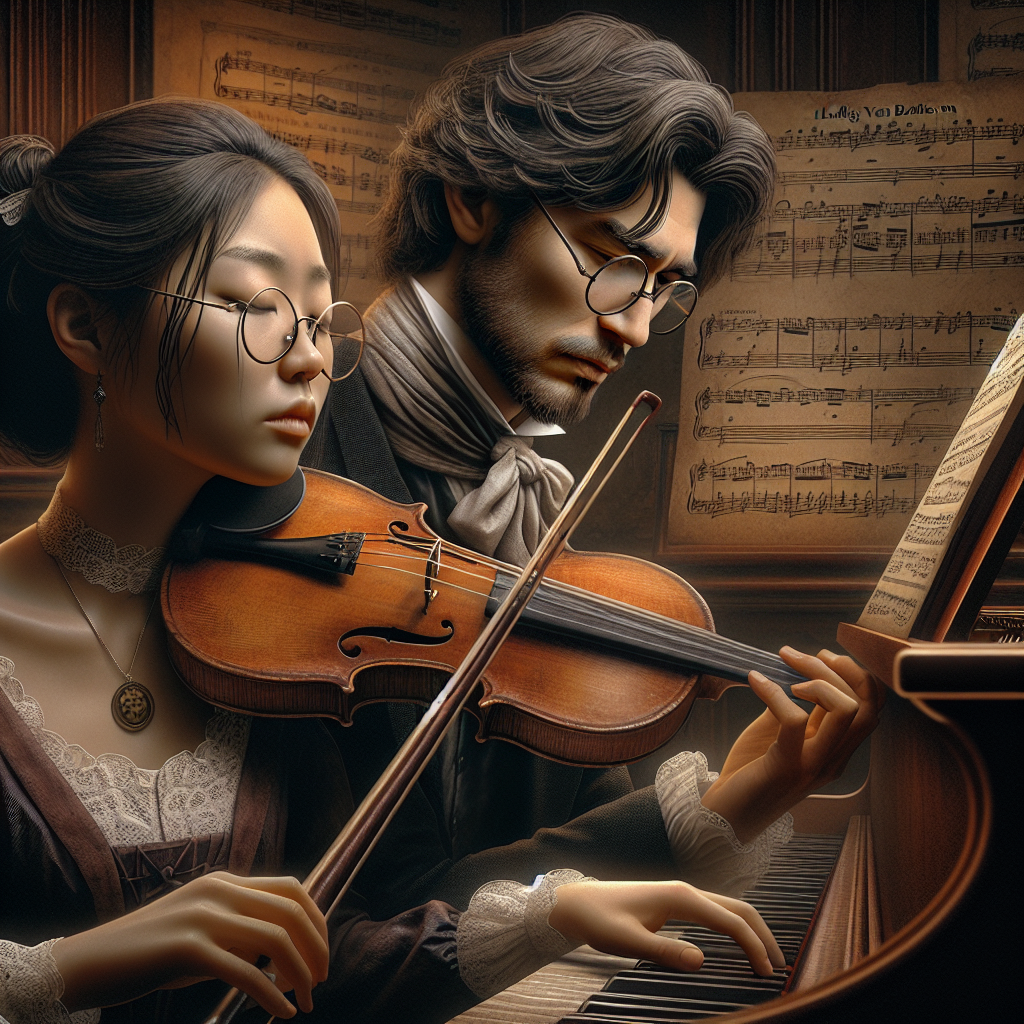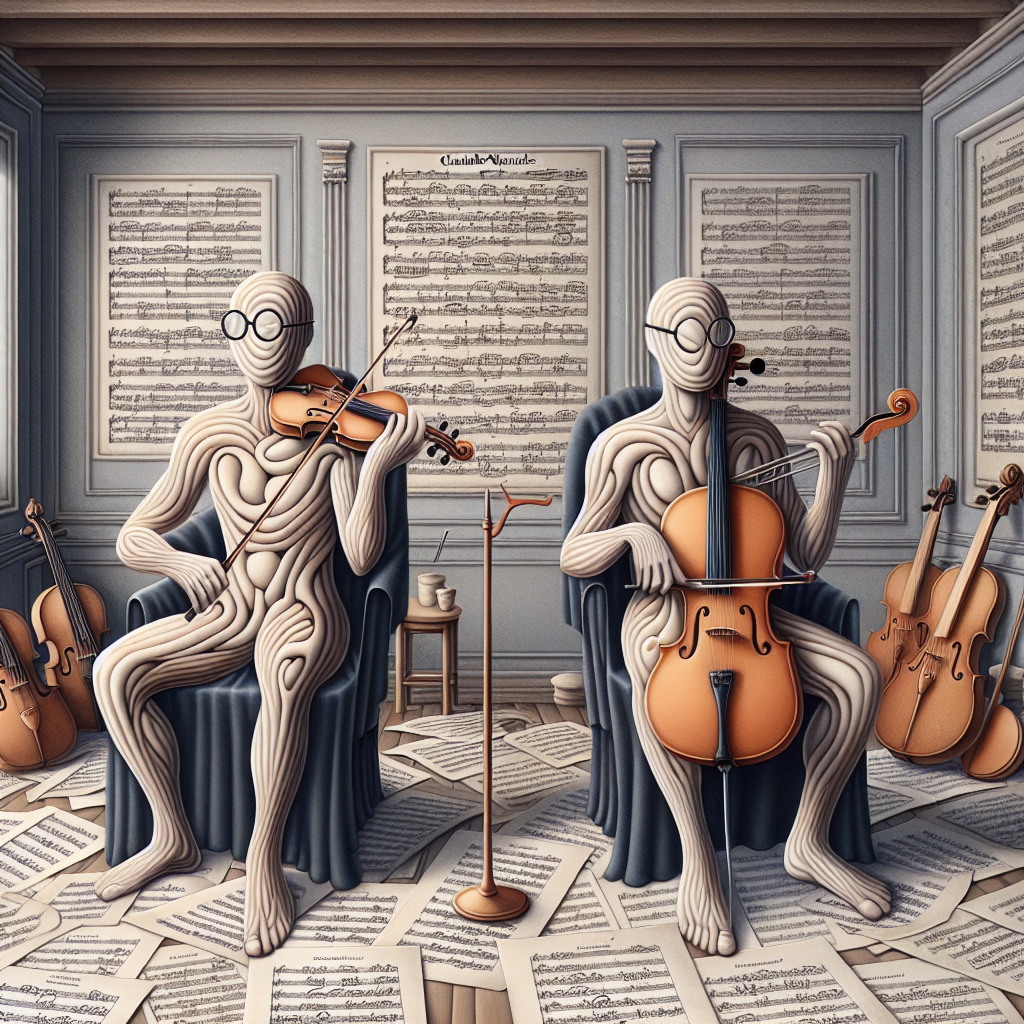
The Eyeglasses Duo: Beethoven’s Chamber Music Insight
Ludwig van Beethoven isn’t just a name in the annals of classical music; he is an epoch in himself. His life and works symbolize the quintessence of sheer genius, overcoming adversity to produce timeless compositions that still resonate with audiences today. Despite the monumental symphonies and groundbreaking piano sonatas, Beethoven also made substantial contributions to the more intimate setting of chamber music. Among these works, “The Eyeglasses Duo” or “Duet with Two Obligato Eyeglasses” stands out, not only for its delightful music but also for its whimsical title and backstory.
Beethoven’s foray into chamber music reflects his keen interest in creating dialogues between instruments, offering a comprehensive yet emotionally nuanced exploration of musical motifs. Often perceived as lighter and more personal than his large-scale works, his chamber pieces reveal a different facet of his genius—one marked by humor, charm, and an intimate understanding of the conversational quality inherent in this genre. The Eyeglasses Duo, written for viola and cello, epitomizes this facet, providing an intimate glimpse into Beethoven’s humor, friendship, and inventive spirit. Dive into this article as we explore the genius of Beethoven’s chamber works through the lens of The Eyeglasses Duo, unraveling its historical context, its charming nuances, and its enduring legacy.
The Origins of the Eyeglasses Duo:
Every masterpiece has a story, and The Eyeglasses Duo is no exception. Composed around 1796-1797, the piece was fondly named due to Beethoven’s close relationships with Nikolaus Zmeskall and possibly another friend, often cited to be Carl Philipp. The title, “Eyeglasses Duo,” is a playful nod to the need both of these friends had for glasses—a humorous reflection of Beethoven’s lighter side. Unlike his other chamber pieces, this composition was not intended for public performance but for informal gatherings, perhaps in Baron Zmeskall’s salon, where such works were frequently performed for a small circle of friends.
Baron Nikolaus Zmeskall von Domanovecz was not just any friend, but an ardent supporter and fellow musician who played both the cello and the viola. His relationship with Beethoven was one built on mutual respect and camaraderie, with Zmeskall acting at times as a confidant and intermediary in Beethoven’s dealings. The Eyeglasses Duo can be seen as a musical expression of this friendship, capturing in its brief, yet playful movements, the essence of a relaxed, informal exchange between two friends rather than a formal concert setting.
Understanding the Music:
The Eyeglasses Duo, composed for viola and cello, reveals Beethoven’s skill in creating rich textures and intricate dialogues within a compact ensemble. The choice of instruments—typically not paired alone—offers a unique blend of timbral qualities. The viola, with its deeper and more resonant tones, provides a complementary balance to the cello’s rich and warm sonority. This pairing allows for a conversation that is both engaging and intimate.
The piece typically consists of two movements: an Allegro and a Minuet. The Allegro movement is lively and spirited, showcasing Beethoven’s ability to intertwine melodies and harmonies seamlessly. This movement engages listeners with its playful nature and sophisticated yet accessible structure. The Minuet, on the other hand, brings a more relaxed pace, filled with charm and grace, reflecting the social dance culture of the time. Both movements highlight Beethoven’s knack for weaving subtle humor and geniality into his compositions.

The Legacy and Reverence:
While The Eyeglasses Duo might not be as famous as Beethoven’s symphonies or piano sonatas, it holds a special place in the chamber music repertoire. Its charm lies in its simplicity and the personal touch that Beethoven imparted. The piece’s informal and amicable nature serves as a reminder of the composer’s multifaceted personality—an aspect often overshadowed by the monumental weight of his more famous works. Moreover, The Eyeglasses Duo has been embraced by chamber music enthusiasts and professional musicians alike, who appreciate its playful elegance and intimate atmosphere.
In modern times, The Eyeglasses Duo is not only performed in formal concerts but is also celebrated in more intimate venues such as chamber music festivals and private recitals. This versatility enhances its appeal, bridging the gap between casual listeners and classical aficionados. The piece serves as an accessible entry point for those who may be new to Beethoven’s chamber music, offering a delightful listening experience that captures the essence of his lighter, more personal side.
Reinnovating Chamber Music:
Beethoven’s contributions to chamber music extend far beyond The Eyeglasses Duo. His string quartets, piano trios, and various other ensemble works have left an indelible mark on the classical music landscape. Nevertheless, The Eyeglasses Duo offers a glimpse into the more personal and humorous side of his artistry. It exemplifies how Beethoven could innovate within the constraints of a smaller format, creating works that are both deeply engaging and technically masterful.
Beethoven’s chamber works often pushed the boundaries of form and expression, experimenting with new structures and harmonic language. In The Eyeglasses Duo, we see the early stages of this innovative spirit. The music, while lighthearted, exhibits moments of profound creativity and complexity, serving as a precursor to some of his more advanced chamber compositions. This ability to balance humor with depth makes The Eyeglasses Duo a unique and invaluable part of Beethoven’s oeuvre.
Personal Reflections and Musical Intimacy:
The Eyeglasses Duo, beyond its technical and historical significance, offers a deeply personal reflection of Beethoven’s life and relationships. It provides a tangible connection to the man behind the music, revealing the warmth, humor, and kinship that characterized his private interactions. This personal dimension is what makes chamber music, and particularly this piece, so compelling. Unlike the grand gestures of symphonic works, chamber music invites listeners into an intimate space, encouraging them to explore the subtleties and nuances of human expression through sound.
Listening to The Eyeglasses Duo today, one can almost imagine the setting in which it was first performed—a small room filled with friends, laughter, and the easy rapport of shared creativity. This intimate context enhances our appreciation of the work, transforming it from a mere piece of music into a living, breathing testament to friendship and artistic collaboration. It’s these qualities that continue to captivate audiences, inviting them to experience a side of Beethoven that is often overshadowed by his more monumental achievements.
Conclusion:
The Eyeglasses Duo stands as a testament to Beethoven’s ability to weave humor, intimacy, and technical mastery into a charming piece of chamber music. It offers a refreshing perspective on a composer often associated with dramatic and monumental works, showcasing a lighter and more personal side of his genius. Despite its brevity and informal origins, The Eyeglasses Duo has carved out a significant niche within the chamber music repertoire, beloved by musicians and audiences alike for its wit, charm, and elegant simplicity.
In exploring The Eyeglasses Duo, we gain not only a deeper understanding of Beethoven’s multifaceted personality but also an appreciation for the enduring relevance of his chamber works. This piece serves as a gentle reminder of the power of music to connect us, transcending time and space to touch the very essence of human interaction and creativity. As we continue to celebrate and perform Beethoven’s chamber music, The Eyeglasses Duo remains a cherished part of his legacy, offering an intimate glimpse into the heart and mind of one of music’s greatest innovators.